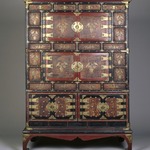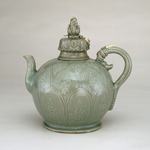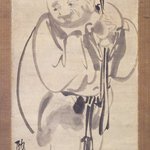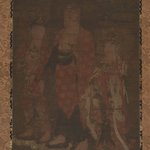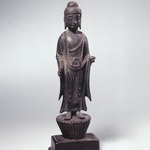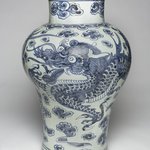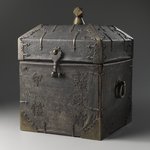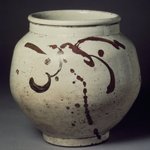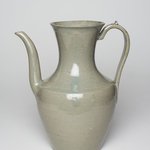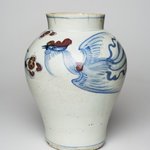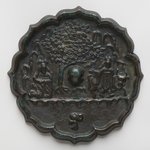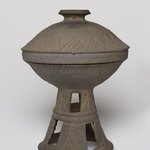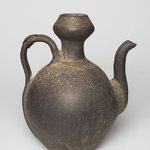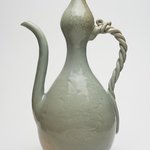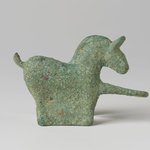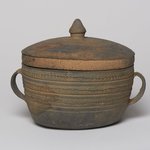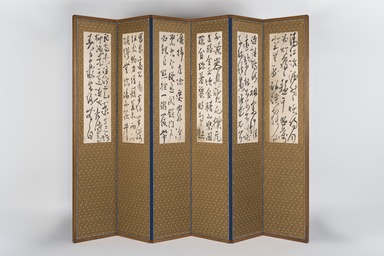
Calligraphy
Jeon Gi
Asian Art
On View: Asian Galleries, South, 2nd floor
ARTIST
Jeon Gi, Korean, 1825 – 1854
MEDIUM
Six-panel folding screen: ink on paper
DATES
Second Quarter of 19th century
DYNASTY
Joseon dynasty
DIMENSIONS
image: 38 3/16 × 11 13/16 in. (97 × 30 cm)
storage (Typically stored in donor's custom blue fabric cover.): 77 × 18 1/2 in., 5 lb. (195.6 × 47 cm, 2.27kg) (show scale)



MARKINGS
Two seals of the artist on the far left panel.
COLLECTIONS
Asian Art
ACCESSION NUMBER
2022.37.5
CREDIT LINE
Gift of the Carroll Family Collection
CATALOGUE DESCRIPTION
Six panels of loosely brushed Chinese characters, running vertically. Style fluctuates between legible and very broadly cursive. Content to be translated.
Jeon Gi (also known as Goram) was a student of Kim Jung-hi (also known as Wandang or Chu'sa, 1786-1857, the most eminent calligrapher and Chinese classicist of his time in Korea. Together with Cho Hui-ryong (aka Uh-bong, 1797-1859) and Ho Ryon (aka So-chi, 1809-1892), they constituted the Chusa school of calligraphy (named after their teacher's sobriquet), which looked to the Chinese Southern school of calligraphy.
Jeon Gi lived to only 30 years old, so his output was small and very few examples of his work survive. There are also paintings in his hand.
EXHIBITIONS
MUSEUM LOCATION
This item is on view in Asian Galleries, South, 2nd floor
CAPTION
Jeon Gi (Korean, 1825 – 1854). Calligraphy, Second Quarter of 19th century. Six-panel folding screen: ink on paper, image: 38 3/16 × 11 13/16 in. (97 × 30 cm). Brooklyn Museum, Gift of the Carroll Family Collection, 2022.37.5 (Photo: Brooklyn Museum, 2022.37.5_PS20.jpg)
IMAGE
overall, 2022.37.5_PS20.jpg. Brooklyn Museum photograph, 2023
"CUR" at the beginning of an image file name means that the image was created by a curatorial staff member. These study images may be digital point-and-shoot photographs, when we don\'t yet have high-quality studio photography, or they may be scans of older negatives, slides, or photographic prints, providing historical documentation of the object.
RIGHTS STATEMENT
No known copyright restrictions
This work may be in the public domain in the United States. Works created by United States and non-United States nationals published prior to 1923 are in the public domain, subject to the terms of any applicable treaty or agreement.
You may download and use Brooklyn Museum images of this work. Please include caption information from this page and credit the Brooklyn Museum. If you need a high resolution file, please fill out our online application form (charges apply).
The Museum does not warrant that the use of this work will not infringe on the rights of third parties, such as artists or artists' heirs holding the rights to the work. It is your responsibility to determine and satisfy copyright or other use restrictions before copying, transmitting, or making other use of protected items beyond that allowed by "fair use," as such term is understood under the United States Copyright Act.
The Brooklyn Museum makes no representations or warranties with respect to the application or terms of any international agreement governing copyright protection in the United States for works created by foreign nationals.
For further information about copyright, we recommend resources at the United States Library of Congress, Cornell University, Copyright and Cultural Institutions: Guidelines for U.S. Libraries, Archives, and Museums, and Copyright Watch.
For more information about the Museum's rights project, including how rights types are assigned, please see our blog posts on copyright.
If you have any information regarding this work and rights to it, please contact copyright@brooklynmuseum.org.
RECORD COMPLETENESS
Not every record you will find here is complete. More information is available for some works than for others, and some entries have been updated more recently. Records are frequently reviewed and revised, and we welcome any additional information you might have.
